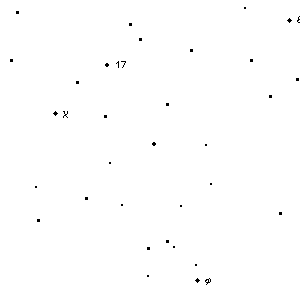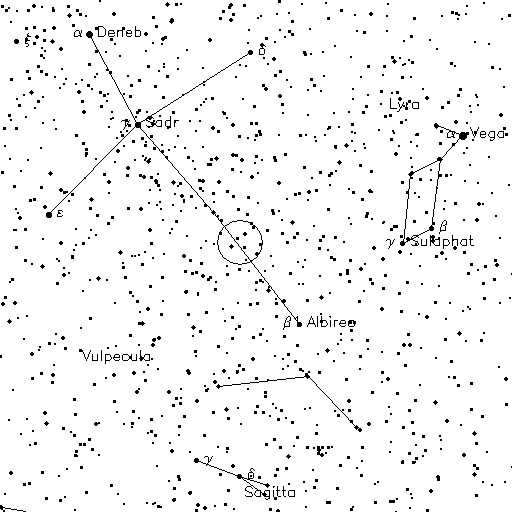According to today’s April 11 IAU Circular 8934, issued by the Central Bureau for Astronomical Telegrams at the Smithsonian Astrophysical Observatory in Cambridge, Massachusetts a 7th-magnitude nova was discovered on April 10, 2008, by Koichi Nishiyama and Fujio Kabashima in Japan. It’s time to observe!
The event is located in Cygnus, about one-third of the way from Albireo (β Cygni) to Sadr (γ Cygni) – RA 19 43 0 Dec +32 19. From early reports, it may still be continuing to brighten. Ernesto Guido and Giovanni Sostero of Remanzacco, Italy confirmed the discovery before the IAU announcement was made and estimated the nova’s magnitude at 7.5 at approximate 09:00:00 UT, 11 April 2008.
 This image above is a map of Cygnus where the dimmest star shown is magnitude 7.5. The target area is circled. Binoculars and small telescopes are very capable of seeing this event! The zoomed map you see here is slightly larger than a binocular field of view and features the target area. The magnitudes are also set to 7.5. Should the event brighten, any stars you see that are in the target area brighter than what is shown will be the nova event.
This image above is a map of Cygnus where the dimmest star shown is magnitude 7.5. The target area is circled. Binoculars and small telescopes are very capable of seeing this event! The zoomed map you see here is slightly larger than a binocular field of view and features the target area. The magnitudes are also set to 7.5. Should the event brighten, any stars you see that are in the target area brighter than what is shown will be the nova event.
If any updates or corrections occur, I will post them immediately. Clear skies and good luck!



There seems to be alot of activity in this area. Check out Lacerta for other activity.
Good work. I wonder what this looks like from Germany?
Once these cloudy skies and snow finally get out of here (damn this global cooling!) I’ll be out there trying to pin this thing down.
Could it be that we will finally see a supernova in our lifetime?
Here’s a picture of the beasty:
http://www.fototime.com/%7BD8FAD43C-9F9D-4375-B4BA-6249942E4C5E%7D/picture.JPG
In Cygnus, yet. A (relatively) local event? Gentlemen, start your spectrographs! I want substance!
Cygnus, the fall’s early evening harbinger of the bird migration, here under the Great Atlantic Flyway, it looks like a long necked goose flying south for the winter, the New Star is at the base of the neck, overhead just after local midnight.
A Nova for the people. Thanks, so much, for the heads up!
Great! One question: isn’t it a nova? According to the IAU circular it is. I think you have to change the title of the post.
There was a nova in this area in 2001:
http://www.zen32156.zen.co.uk/nova_cygnus.htm
If the clouds ever clear from this area, I’ll have a look-see through my 10″ LX90
Is this an actual photograph or an artist’s rendering?
Attribution should always be given.
It’s a NOVA, NOT a supernova!!!
Nothing but a thermonuclear explosion on the surface of a white dwarf. These occur several times a year in our galaxy alone, and are nothing special. This one is a bit brighter than most, and, yes, may still be on the rise according to early spectroscopy results, but it will probably not reach naked-eye visibility.
Sorry! It really is a nova event, and the change has been made. (what would i do without you guys? you’ll make a writer out of me yet. ;)) I was just anxious to put the alert out and get outside!
I was really excited last night because after the tornadoes blew through the skies cleared here and I had an opportunity to see it. Events of this type might not be everyone’s cup of tea, but I dearly love observing anything that’s off the beaten path.
Thanks for the image Qev! And Robert? I put the disclaimer it was an artist’s rendering in the title, but we’ve changed systems a bit and the “mouse over” doesn’t show. I’ll work on it and see what I can do to make sure image information is more easily noticed.
In the mean time, if anyone gets a photo of it, please send it to me and I’ll post it!
Wishing you clear skies…
…and some of us with very looong memories remember this…
http://en.wikipedia.org/wiki/V1500_Cygni
It was 1975 and I had been in The York Astronomical Society for some two years. Some very kind old grandee’s in the society gave us sprogs a lift to the observatory and shewed us V1500 Nova Cygni 1975…
Happy days (or nights…)
regards all
Martin
Just got home from STARING at this thing for about 10 to 15 minutes at friends observatory. One major comment, WOW, I saw it! The haze (or whatever it is called on that type nova) is getting gorgeous. I feeel so lucky to get that view. Can I hug the galaxy now? 🙂
AAVSO has a lot of info on this nova and soon to be a finder chart too.
http://www.aavso.org/publications/specialnotice/103.shtml
Congratulations, Kootstar!!! Not too shabby, huh? 😉
Latest from AAVSO:
CBET 1334 (D. Green, Ed., Central Bureau for Astronomical Telegrams)
announces that K. Ayani, Bisei Astronomical Observatory and K. Matsumoto,
Osaka Kyoiku University, Japan, write that low-resolution spectra of
V2491 Cyg obtained Apr. 11.72 UT indicate that the object is a nova in
its early phase of outburst. Fe II emission may be present.
V2491 Cyg has been added to VSX (pending approval) and has been assigned
the identifier VSX J194301.9+321913. It has also been assigned the AAVSO
unique ID 000-BFT-191.
Since the ancestral time, world space research is progressing on wrong concept because we unknown about space mirror which is a great mystery and creator of lots of mysteries viz. milk ways, galaxies, nebulas, supernovas, white dwarfs, black holes etcs. Hence without study of space mirror the space research has no future.
It can not explain in short. Therefore it invites to visit http://www.spacemirrormystery.com to know the logic and original truth.
Mirror reflects frontier. Mirror functions like a wall. There is nothing ahead of mirror but reflection makes lively atmosphere into mirror. If two mirrors face each other in parallel position the concerned area between mirrors is converted to a biggest atmosphere because the concerned area reflected unlimitedly as front side and backside into each mirror frequently. Space mirror is based on above rule and we are unknown about space mirror. From sun the objects of area 225 million kilometer to 300 million kilometer of solar system reflects unlimitedly, we find a very deep space and through giant telescopes we watch mystery after mystery. Telescope enlarges view not closes near view. Following may clear the concept “A visitor of a desert often find mirage. If he moves mirage also moves. He can never reach near the mirage. If he tries he can see enlarge view of mirage as smoky atmosphere through a telescopic instrumentâ€.
Giant telescope like Hubble and others may be the milestone of our technology but it can not help the real space research.
Hey pradipta,
Lay off the silly space mirror SPAM, OK? I wouldn’t visit your Web site on a bet, as it’s probably laced with viruses.